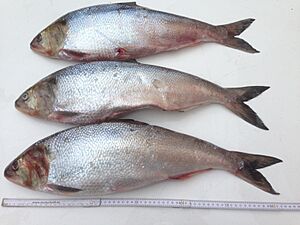Allis shad facts for kids
Quick facts for kids Allis shad |
|
|---|---|
 |
|
| Conservation status | |
| Scientific classification | |
| Genus: |
Alosa
|
| Species: |
alosa
|
The allis shad (Alosa alosa) is a type of fish found in the Northeast Atlantic Ocean. It belongs to the Alosidae family. This fish is known as an anadromous species. This means it lives in the sea but travels into fresh water, like rivers, to lay its eggs.
You can find the allis shad in the eastern Atlantic Ocean, the western Baltic Sea, and the western Mediterranean Sea. It looks a lot like an Atlantic herring. However, you can tell it apart by a clear dark spot right behind its gill cover. Sometimes, it even has a row of up to six more spots after that first one. Allis shads sometimes breed with the twait shad (A. fallax), creating mixed offspring.
These fish become ready to reproduce when they are about three years old or older. They then swim from the sea into estuaries (where rivers meet the sea) and up rivers to spawn. Sadly, the number of allis shads has gone down. This is mainly because of too much fishing, pollution, and places where they live being destroyed. Efforts to protect this species are part of important agreements like the Bern Convention and the European Community Habitats Directive.
Contents
What Does the Allis Shad Look Like?
The allis shad is shaped like a typical herring. It does not have a lateral line, which is a special sensing organ many fish have. Its belly is somewhat rounded. The gill cover has ridges, and its scales are quite large.
The back of the allis shad is a bluish-green color. Its head is brownish, with a golden shine on the operculum, which is the bony flap covering the gills. Its sides are silvery, sometimes with a bronze tint. A very noticeable large dark spot is found just behind the gill cover. Sometimes, there are one to six smaller spots behind this main one. Adult allis shads usually grow to be about 30 to 60 centimeters long.
Where Does the Allis Shad Live?
The allis shad lives in the eastern Atlantic Ocean. It is found in the waters along most of Europe and northwestern Africa. It also enters the western Baltic Sea and the western Mediterranean Seas. However, it is not very common outside of France.
How Does the Allis Shad Live and Grow?
The allis shad (Alosa alosa) has a life cycle similar to that of the twait shad (A. fallax). These two species are known to live in the same areas, which is called sympatry. They can also breed with each other, creating hybrid fish. Like many other fish in the Alosa group, they are anadromous. This means they move between fresh water and salt water. However, some allis shads have been found living only in fresh water, showing they can adapt well.
These fish spend most of their lives in the sea, where they feed. When they are ready to reproduce, they travel to their spawning grounds. This journey usually happens between April and June. Allis shads typically become mature and ready to spawn when they are between 3 and 7 years old. Most A. alosa fish can only reproduce once in their lives. Young allis shads appear in estuaries (where rivers meet the sea) and slightly salty water around July to August. The saltiness of this brackish water can sometimes be a challenge for the young fish moving from fresh water.
Why Are Allis Shad Numbers Declining?
The number of allis shad fish has gone down mainly because of three reasons:
- Overfishing: Too many fish are caught, more than the population can replace.
- Pollution: Harmful substances in the water damage their habitat and health.
- Habitat destruction: Places where they live and spawn are being damaged or lost.
Young allis shads spend a period in estuaries as they move from their spawning grounds to the sea. This "estuarine phase" for A. alosa is thought to last up to six months. However, this estimate does not fully consider how individual fish might differ or how well young fish survive in these estuarine areas.
How Is the Allis Shad Being Protected?
To help protect the allis shad, four special areas have been set aside in Ireland. These are places where Alosa species are known to spawn. The allis shad (A. alosa) is listed in Appendix III of the Bern Convention (1979). This list includes protected animal species. It is also in Appendix II and V of the European Community Habitats Directive (1992). Appendix II lists species that need special areas of conservation. Appendix V lists species that need careful management.
In France, a temporary ban (called a moratorium) was put in place in 2008. This ban stops fishing for A. alosa in many French rivers to help their populations recover.




